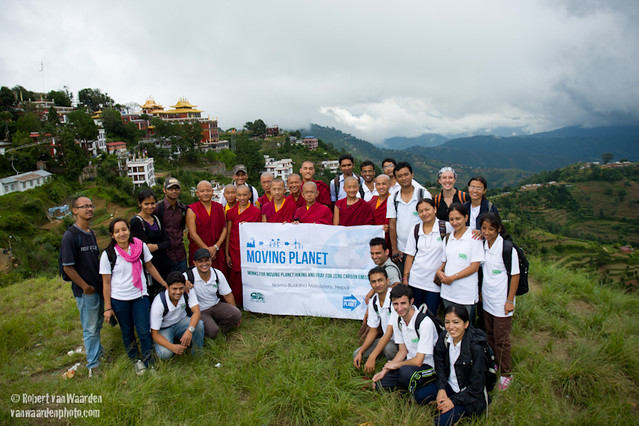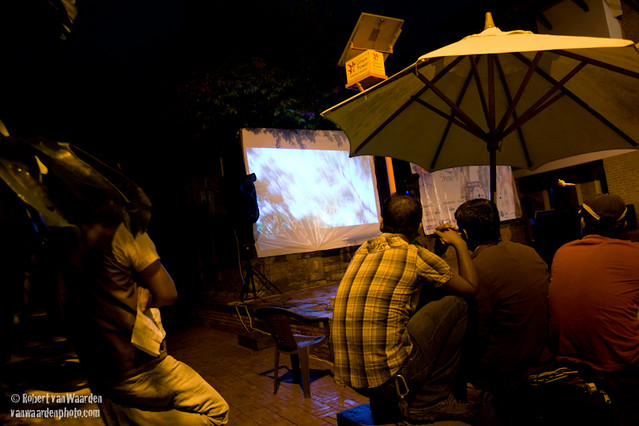Most recent work in progress from upcoming Climate Oxide Exhibit.
Opening: Oct. 19, 2012, 20:00 Kunstkerk, Amsterdam
Most recent work in progress from upcoming Climate Oxide Exhibit.
Opening: Oct. 19, 2012, 20:00 Kunstkerk, Amsterdam

“I have seen a bright future for wind energy in Nepal, because a lot of wind energy potential has been predicted,” says Aruna Awale, manager of the wind energy department at the Alternative Energy Promotion Centre in Kathmandu, Nepal.
From the window of her office, she can see one of the few operating wind turbines in Nepal. It is a small Maglev vertical access turbine. It turns rapidly in the wind that blows through the Kathmandu valley. It is a sign of more to come if Ms. Awale has anything to do with it.
Ms. Awale works on data and implementation projects, co-ordinates meetings and conferences, and meets with national and international stakeholders. She credits her work for giving her more confidence and a huge amount of experience. She especially enjoys the opportunity to travel internationally for different seminars, the highlight of which is often a visit to a wind farm.
Nepal faces several problems to implement large-scale wind energy, but interestingly, one of those isn’t finance with many development banks, institutions, or companies ready to step forward. Instead Ms Awale mentions the complex geography and the insufficient infrastructure as the main challenge. The small roads, or entire lack thereof, are often not suited for carrying large equipment to high windy points. The spectacular but difficult geography makes studies and installations more difficult. In order to fully grow in this energy sector, this challenge will have to be surmounted.
Perhaps suggest Ms. Awale, one way to do that is to start smaller. Citing a recent implemented pilot project by the Asian Development Bank, Ms. Awale remains confident that wind energy will have a great impact on small communities in Nepal. In the Dhaubadi BDC of Nawalparasi District, 46 households are now connected to electricity by a small wind turbine. This hastransformed the village and made it the envy of neighbouring villages: now everyone wants a wind turbine.
“With small scale wind energy, thousands of villages can benefit from wind power where no energy is available, not even for lights.” says Ms. Awale.
Ms. Awale has been working at the AEPC for almost a decade and hopes to see some of the available 3000MW potential in Nepal developed, recognizing that it will change the life of many of her fellow Nepalis . For many a Nepali, the answer to electricity problems and the attached poverty issues may simply be blowing in the wind.
This blog post is part 8 of a series of wind energy stories from photographer Robert van Waarden. Next week meet Jaap van der Beek, Netherlands farmer who harvests wind amongst his tulips.

The project I am working on with Dutch/Nepali artist Shiva Rimal, Climate Oxide, was recently mentioned in Weesper Nieuws (a local dutch newspaper). This project is a focus on climate change and identity in Nepal, Canada and the Netherlands. Marieke van Veen wrote a beautiful story on Climate Oxide & Shiva Rimal in a page long interview. This interview is in Dutch, for those interested, click on the image below or click here to go to the pdf file to read the full story.
This guest post is cross-posted from 350.org and written by Anna Keenan detailing our recent experience in Nepal.
I spend most of my time working as a climate campaigner for Greenpeace International in Amsterdam, however for the 2011 global day of climate action – Moving our Planet beyond fossil fuels – I have somehow ended up in Kathmandu, Nepal, with climate-activist photographer Robert van Waarden. I simply couldn’t resist the opportunity to write about what “Moving Planet” has been like in this magical (and slightly crazy) city of contrasts!
Today, there was not just one, but three major events in the Kathmandu area.

First – we were up at 5am to make it on the bus to Dulikhel with Small Earth Nepal, a wonderful organization who are working on many aspects of sustainability – from awareness-raising, to scientific methodological training, to promoting biogas in rural villages. Today, 100 people hiked from Dhulikhel to Namo-buddha Monastery – where over 350 young monks are living and learning Tibetan Buddhist philosophy. The monks led our group in a meditation on a Zero-Carbon Future.
Aside from philosophical leadership, these monks are also into practical action. One of the many interesting initiatives at the monastery is the on-site production of heating briquettes from the monastery’s paper waste and agricultural waste. These carbon-neutral briquettes are burnt in place of firewood (which is in short supply) to keep the monastery buildings warm in winter – and because the briquettes burn without smoke, they also improve air quality.

The second event – Nepalese Youth for Climate Action, along with Kathmandu Cycle City 2020, organised a cycle rally with over 120 keen young cyclists participated! In Kathmandu, every intersection is a chaotic, noisy blur of pedestrians, motorcycles, rickshaws, bicycles, taxis, trucks, as well as chickens, dogs and cows, all competing for space. The diesel fumes choke the city and many residents suffer from allergies or skin reactions. Cycling is not only good for the global climate – it could be a great solution to the local air-quality problem, and with no fuel costs, it is affordable – a big concern for most residents! However, the traffic chaos makes cycling a dangerous choice for anyone trying to ‘do the right thing’. Today’s cycle rally promotes the goal of Kathmandu being cycle-friendly within the decade – these young people are campaigning for cycle lanes so that more people can choose to cycle, in safety.

The third event was a fully solar-powered screening of short eco-films from around Nepal, run by Story Cycle. The solar panels charged the batteries during the day, and when the sun set on Patan’s Durbar Square, that renewable energy powered (despite rainy conditions!) a screening of 15 short films, made by young people, about local eco-issues in Nepal and South Asia.
These three events are just the tip of the iceberg (or should I say instead ‘just the edge of a great Himalyan glacier’?) of the Nepali sustainability initiatives that we have had the pleasure of learning about over the last few weeks. With so many different types of climate action happening in one place, and so many inspiring, intelligent young people on the case, a sustainable future for Nepal is looking more likely every moment.

Tommorrow I leave for Nepal.
Nepali/Dutch artist Shiva Rimal and I are off to work on our collaborative art project Climate Oxide. It is a documentation of climate change impacts around the world using photography, steel and rust. We will visit various climate adaptation projects, trek in the Himalayas and take part in the Moving Planet action in Kathmandu on September 24.
About the Project
Robert van Waarden and Shiva Rimal create items of visual art using the mediums of photography, steel, and rust. Their current project, Climate Oxide, uses this art form to symbolize how climate change is impacting our world. Reflecting on their heritage, Nepali and Canadian born artists with Dutch nationality, they will personalize the climate issue to the viewer by visualizing the impacts on their individual environments.
The combination of this aesthetic art form and story is unique and is interesting for a wide audience. Publications and galleries/outlets are invited to contact the artists for more information and to explore opportunities to display the resulting body of work.
Stay tuned for more. I will return in the first week of October.